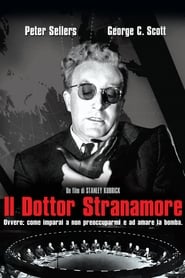Il dottor Stranamore, ovvero: come ho imparato a non preoccuparmi e ad amare la bomba
Titolo originale: Dr. Strangelove or: How I Learned to Stop Worrying and Love the BombRegia: Stanley Kubrick |
Anno: 1964
Origine: United Kingdom | United States of America |
Generi: Commedia Guerra
Tag: usa president | general | cold war | strategic air command | dark comedy | nuclear missile | satire | black and white | cynical | war room | bomber pilot | nuclear weapons | ex-nazi | anti war | doomsday device | absurdism | satirical | playful | absurd | critical | hilarious | audacious | farcical | sardonic |
Cast: Peter Sellers | George C. Scott | Sterling Hayden | Keenan Wynn | Slim Pickens | Peter Bull | James Earl Jones | Tracy Reed | Jack Creley | Frank Berry | Robert O'Neil | Glenn Beck | Roy Stephens | Shane Rimmer | Hal Galili | Paul Tamarin | Laurence Herder | John McCarthy | Gordon Tanner | Burnell Tucker | Victor Harrington | Peter Evans |
Uno psicopatico generale dell'aviazione USA, deciso a salvare il mondo dal complotto comunista, è pronto ad attaccare l'Unione Sovietica con armi nucleari. Uno dei pochi capolavori di satira politica nella storia del cinema che riflette gli incubi apocalittici dei primi anni '60. Il più forsennato e meno controllato film di Kubrick con Peter Sellers in 3 ruoli al culmine del suo istrionismo. Non vinse nemmeno uno dei 4 Oscar cui era candidato. Dal romanzo Red Alert (1958) di Peter George che lo sceneggiò con Terry Southern e il regista.
